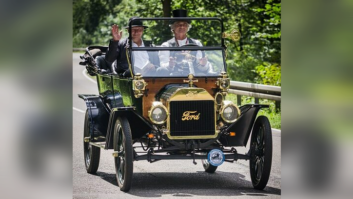
Rádio Gaúcha’s Sports Coordinator Rafael CechinRIO DE JANEIRO — After 64 years, the 2014 FIFA World Cup returned to Brazil this summer. The soccer games, played from June 12 to July 13, comprised the 20th FIFA World Cup, the tournament for the association’s football world championship, held at several venues in the country.

FIFA is the Fédération Internationale de Football Association, the sport’s governing body. The World Cup had last been held in Brazil in 1950.
As the country with the most World Cup titles, Brazil’s radio coverage of the event was assured a rabid following. A total of 21 Brazilian stations aired matches.
For approximately $850,000 each in transmission fees, Brazilian radio stations acquired permission to broadcast from rights-owner GloboSat. The figure is about three times the amount paid by the country’s stations during the prior World Cup in South Africa in 2010, according to FIFA and ABERT, the Brazilian Association of Radio and TV Stations.
STAFF COVERAGE

In Porto Alegre in the lower southeast portion of the country, close to neighboring Uruguay, Rádio Gaúcha is the main radio station in the region. It began preparing for the event in 2011. Management decided to place at least one professional staff member in each of the 12 host cities.
Rádio Gaúcha implemented a series of measures necessary for successful coverage. “The Confederations Cup, in 2013, served as a kind of lab for what we wanted this year. “[We used] our entire budget for this commercial project,” said Rafael Cechin, the station’s sports coordinator.
Since the station was broadcasting fromall the 2014 World Cup venues, it was able to broadcast all 64 games and corresponding information. The station also had a strong presence at the International Broadcast Centre in Rio de Janeiro. The IBC was FIFA’s broadcast headquarters during the tournament.
Rádio Gaúcha had reserved its space, which served as a studio and newsroom for the team of six staff members who stayed in Rio during the games; the station shared the space with officials from FIFA and Host Broadcast Services.

Described by designer Christopher Lee as “the most perfect stadium in South America,” the Estádio das Dunas in Natal, in the Brazilian state of Rio Grande do Norte, was built to host a number of World Cup matches. The station had 31 accredited staff members, of which 20 were traveling during the Cup. “The newsroom in Porto Alegre had an additional 15 staff members who were directly involved with the coverage. And all our employees, including the areas of journalism, administrative, transportation, technical and commercial departments, were mobilized for the World Cup in Brazil,” said Cechin.
Rádio Gaúcha had studios equipped with digital circuits and equipment in all the World Cup venues — ISDN connections at the stadiums, studios and the IBC, with IP connection as a backup. Wherever the Brazilian team went, the station’s staff members travelled with them. The IBC in Rio de Janeiro and Porto Alegre also made special preparations. Reporters for Rádio Gaúcha had mobile connectivity using Comrex Access stereo BRIC IP audio codecs, which are portable and use 4G modems or WiFi for audio transmission; the reporters went on air directly from the stadiums and team training fields. For backup, Rádio Gaúcha used Access codecs but also bought 4G iPhones and touchscreen notebooks for the broadcast team’s use.
SIX-FIGURE OUTLAY
Rádio Tupi, a well-known station in the capitol city of Rio de Janeiro, had nearly 150 staff members involved in covering the World Cup, including technicians, journalists, sports announcers and producers.
“If we take into account the purchase of broadcast rights, equipment purchases, airplane tickets, accommodations and ‘per diem’ costs,” said Thiago Carneiro, the station technical manager, its total financial outlay was about $1.36 million.

Credit: ESPN The station used IP codecs, V.35 or ISDN lines for audio transport, depending on the feasibility and needs for each broadcast. Rádio Tupi used Tieline Commander G3 and AEQ Eagle codecs.
Rádio Tupi aired 40 out of 64 games live. For this, the station invested heavily in Wheatstone AoIP technology for internal audio transport.
“We were able to work on multiple games simultaneously, thus making the operation incredibly simple,” said Carneiro.
The Grupo Bandeirantes stations form the “Rede Verde-Amarela,” or Green-Yellow Network. The network consists of several station groups: BandNews FM, Rádio Bandeirantes, Bradesco Esportes FM, Band FM, Nativa FM and its affiliates. To air the World Cup, these groups chose to form a broadcast chain consisting of more than 130 stations spanning the country.
The entire Green-Yellow Network participated in the coverage of the matches, while five main announcers along with another 35 commentators and reporters presented the broadcasts.
For the network, broadcasting the World Cup in Brazil was a high-cost endeavor. “The acquisition of broadcasting rights made up at least 50 percent of the cost of total coverage operation,” said Rádio BandNews Managing Editor Sheila Magalhães.

To broadcast 56 live games, with portions of the other eight games taking place at the same time in the final round, the station used ISDN lines in the stadiums, and Tieline Commander G3 codecs for live broadcasts.
Employees of the three stations interviewed for this article were unanimous when asked about their biggest challenge: Anyone who believed that the broadcasts would be easier to produce and transmit because the World Cup was in Brazil were mistaken.
All the stations expressed a desire to provide their best coverage, and that played out in different ways. The Rede Verde-Amarela aimed to offer the most extensive coverage for radio listeners with reporters spread across the country. Rádio Tupi strived to inform and guide its audience with the best possible quality and had numerous preparatory staff meetings in the first half of the year.
Thanks to hard work and early preparation, the 21 stations say they met their broadcasting goals in offering a unique World Cup experience to its audience.
Érika Carvalhosa contributes to Radio World from Rio de Janeiro, Brazil.







